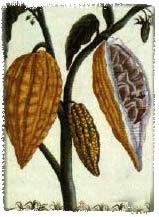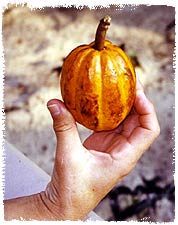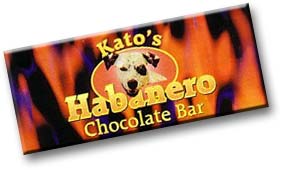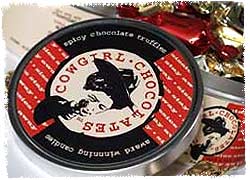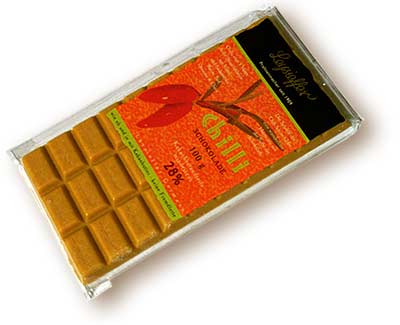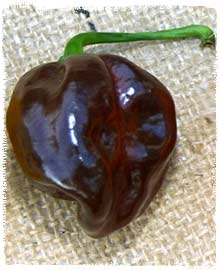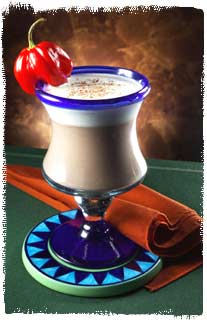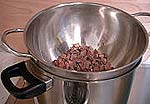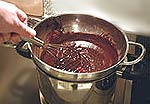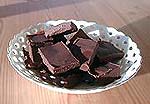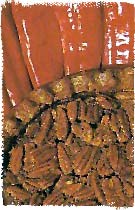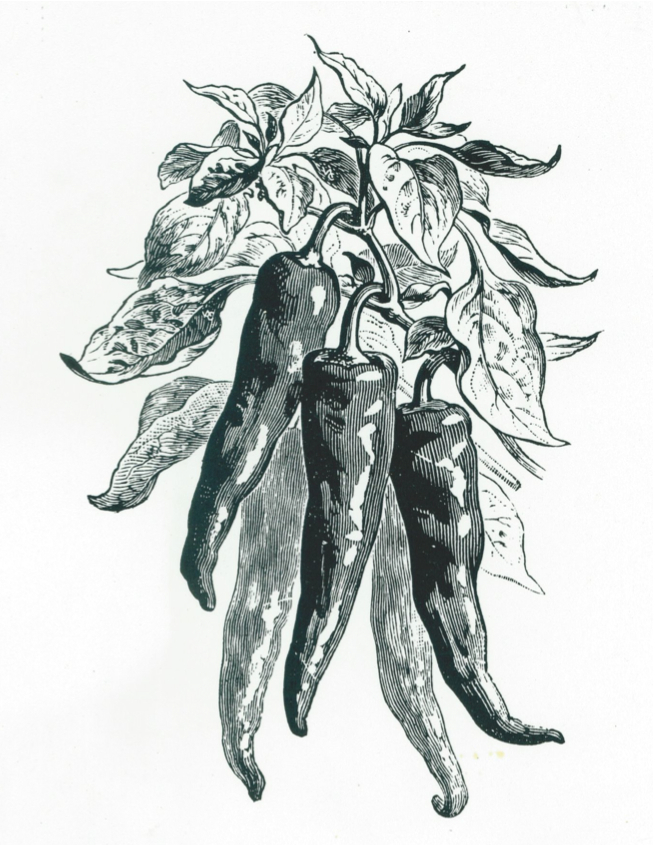by Dave DeWitt
The culinary mating of hot chiles and chocolate was unforgettably revealed to me in the mercado in Oaxaca, where the molinos–grinding mills–in adjacent stalls were processing cacao beans in one stall and mole paste with chiles in the other. In this ancient city, I had this sudden epiphany that, in prehistoric times, ancient cooks would have naturally experimented with combining two of their favorite crops.
|
|
A molinillo, or “little mill,” a tool to froth chocolate
|
The Ancient Chocolate-Chile Civilizations
Later research would reveal how truly old this tradition is. The earliest archaeological evidence that I could dig up dated to A.D. 595, when chiles associated with cacao seeds were found in the Cerén archaeological site in El Salvador. Imagine the surprise of the researchers when they discovered painted ceramic storage vessels that contained large quantities of chile seeds with cacao. “One vessel had cacao seeds in the bottom, and chocolate above, separated by a layer of cotton gauze,” said the lead anthropologist, Dr. Payson Sheets. “It is possible that they would have been prepared into a kind of mole sauce.” (Read the complete Article on Cerén.)
|
|
Cacao bean pod. Inside the
Cacao botanical print,
|
|
We have even more documentation of the Aztecs’ love of chiles and chocolate. In 1529, a Spanish Franciscan friar living in Nueva España (now Mexico) noted that the Aztecs added hot red or yellow chile peppers to their hot chocolate and used them in nearly every dish they prepared. Fascinated by the Aztec’s constant use of a previously unknown spice, Bernardino de Sahagn documented this fiery cuisine in his classic study, Historia General de las Cosas de la Nueva España, now known as the Florentine Codex. His work proves that of all the pre-Columbian New World civilizations, it was the Aztecs who loved chile peppers the most. The market places of ancient Mxico overflowed with chile peppers of all sizes and shapes, and Sahagún wrote they included “hot green chiles, smoked chiles, water chiles, tree chiles, beetle chiles, and sharp-pointed red chiles.”
|
|
Representation of a cacao plant in an Aztec codex
|
The chiles and cacao pods were also paid as tributes or taxes to the Emperor Montezuma, who was quite fond of the combination of chiles and chocolate. Richard Sterling, writing in Fiery-Foods & BBQ magazine, noted that Bernal Díaz, the chronicler of the conqueror Hernan Cortes, made careful observations about the chocolate in his book, The Conquest of New Spain. “The great Montezuma liked his cup of hot cocoa flavored with vanilla, honey, and spiked with a good dose of red chile,” Sterling wrote. “The Conquistadors picked up the habit, too, and brought it to Europe and, of course, the rest is culinary and confectionery history. But Diaz and some others stayed in Mexico carving out huge haciendas and quaffing cocoa in the manner of their admired late foe. They kept the original recipe but expanded on it a bit by adding a splash of “vino de Tequila.” After cattle were introduced to Mexico from Europe they added a little milk or cream. But basically they drank what they emperor had drunk. Only when it had gone through many European hands did the mixture become the confection we know today.”
|
|
Detail of an early 18th century tile panel showing a chocolatada (chocolate party) in Valencia, Spain
|
Díaz observed: “Sometimes they brought him in cups of pure gold a drink made from the cocoa-plant, which they said he took before visiting his wives. We did not take much notice of this at the time, though I saw them bring in a good fifty large jugs of this chocolate, all frothed up, of which he would drink a little. They always served it with great reverence.”
Sophie and Michael Coe, authors of The True History of Chocolate, observe: “Universally popular throughout Mesoamerica was the addition to the drink of chilli, dried and ground to a powder. The Molina vocabulary [the first Nahuatl-Spanish dictionary] calls the drink chilcacahuatl; of course, given the extraordinary array of chillis grown in Mexico, it could be anywhere from mildly pungent to extremely hot.”
After the Spanish conquest of the Aztecs, the story of how chocolate was added to chile sauces does not involve warriors, but rather nuns. Legend holds that mole poblano was invented in the sixteenth century by the nuns of the convent of Santa Rosa in the city of Puebla. It seems that the archbishop was coming to visit, and the nuns were worried because they had no food elegant enough to serve someone of his eminence. So, they prayed for guidance and one of the nuns had a vision. She directed that everyone in the convent should begin chopping and grinding everything edible they could find in the kitchen. Into a pot went chiles, tomatoes, nuts, sugar, tortillas, bananas, raisins, garlic, avocados, and dozens of herbs and spices. The final ingredient was the magic one: chocolate. Then the nuns slaughtered their only turkey and served it with the mole sauce to the archbishop, who declared it the finest dish he had ever tasted.
It’s a nice story, but more likely mole was invented by the Aztecs long before the Spaniards arrived. Since chocolate was reserved for Aztec royalty, the military nobility, and religious officials, perhaps Aztec serving girls at the convent gave a royal recipe to the nuns so they could honor their royalty, the archbishop. At any rate, the recipe for mole poblano was rescued from oblivion and became a holiday favorite.
The Old World Sips Chiles and Chocolate
Although chiles were brought to Europe on the return of Columbus’s second voyage in 1496, it took chocolate longer to arrive. In 1544, a group of Dominican friars led by Bartolomé de las Casas brought a group of Kekchi Maya nobles from Guatemala to the court of Prince Philip in Spain. Among the presents the Maya brought him were feathers of the beautiful quetzal bird, clay vessels, lacquered gourds, various types of chiles, and bowls of beaten chocolate. Apparently this occasion marks the introduction of chocolate into Europe, and according to various historical documents, the drink was very popular, and first commercial shipment of cacao beans from Veracruz arrived in Seville in 1585.
|
|
A nobleman tests the heat of his chocolate in this painting on a Late Classic Maya vase; note tamales covered with chocolate-chile sauce below him.
|
In 1644, the first recipe for a chocolate drink was published in Spain by Antonio Colmenero de Ledesma in his book, A Curious Treatise of the Nature and Quality of Chocolate. Interestingly, it contains chiles. The ingredients were:
-
100 cacao beans
-
2 chiles (black pepper may be substituted)
-
A handful of anise
-
“Ear flower” (whatever that is) *
-
1 vanilla pod
-
2 ounces cinnamon
-
12 almonds or hazelnuts
-
½ pound sugar
-
Achiote (annatto seeds) to taste
All of these ingredients were boiled together and then frothed with a molinillo, the traditional Aztec carved wooden tool. The achiote was used to redden the color of the drink.
Another early chocolate-chile recipe was published in 1692 by M. St. Disdier in France, who was in the chocolate business. The ingredients were:
-
2 pounds prepared cacao
-
1 pound fine sugar
-
1/3 ounce cinnamon
-
1/24 ounce powdered cloves
-
1/24 ounce Indian pepper (chile)
-
1 1/4 ounce vanilla
A paste was made of these dried ingredients on a heated stone and then it was boiled to make hot chocolate. Considering the amount of chile, it was only mildly spicy–the start of an ominous trend. As the popularity of chocolate exploded all over the world after 1700, chiles disappeared as a major ingredient in chocolate drinks, candies, and desserts. No one knows why. Of course, it was still used in traditional Mexican mole sauces, but in other parts world, people wanted sweet, not heat, in their chocolate.
* fiery-foods.com reader John Dencoff sent us this comment:
I live in NM, and sometimes we get interesting spices in from Latin America and South America. “Ear Flower” is sometimes called “sacred ear” (it looks
a little bit like an ear), and is known as “xochinacaztli” (Nahuatl) or “orejuela” (Spanish).
The Modern Transformation
Today, in 2003, a web search for “spicy chocolate” on the Google search engine yields nearly 1400 citations and hundreds of recipes from everything from spicy chocolate popcorn to spicy chocolate chip pumpkin cookies. In the U.S., gourmet food companies like Cowgirl Chocolates, Amour Chocolates, and Kato Productions manufacture chile-chocolate truffles and habanero chocolate bars.
|
|
U.S. Chile Chocolates: |
In Europe, Weisse Schokolade mit Chili (White Chocolate with Chile) is made by Leysieffer, a manufacturer of fine sweets located in Osnabrück, Germany. Chili Traum (Chile Dream) are Dark Chocolate Chili Truffles made by Hamburg’s celebrity baker and chocolatier Adolph Andersen, who has shops in the best locations, including the city’s top hotels. When owner Adolf Andersen created his dark chocolate chile truffles, he was inspired by the movie Chocolate. Our German correspondent, Harald Zoschke, comments: “When I met Andersen, he told me the most important secret: Use the finest ingredients, especially the best chocolate that you can find. Only great chocolate makes great truffles. Anderson uses Valrhona, a very expensive but pure and delicious dark chocolate from France. The truffles have an intense chocolate flavor, melt in your mouth and have just the right kick of heat. Their German online shop offers various assortments of their pralines.
|
|
European Chile Chocolates: Photos by Harald Zoschke |
And finally, here is the ultimate chile-chocolate connection: the ‘Chocolate Habanero’ variety that rated the highest on the heat scale of all chiles tested in 2001 at New Mexico State University! (See test results here.)
|
|
A ‘Chocolate Habanero’ chile variety that is perfect to use with real chocolate Photo by Harald Zoschke
|
Recipes
We have quite a few chocolate-chile recipes in our databases, and they are easy to find. Simply go to our Recipe Search and search for the ingredient “chocolate.” Many more are available by searching Google or Yahoo for “spicy chocolate.” Below are my favorite sweat heat recipes combining chile and chocolate.
The Great Montezuma Hot Chocolate
|
|
The Great Montezuma Hot Chocolate Drink Photo by Steve Tesky
|
Richard Sterling developed this recipe, which is his version of how the Spaniards transformed Montezuma’s favorite beverage, with the addition of alcohol. He commented: “Salud! Drink to the Old World and the New.”
-
12 ounces prepared hot chocolate (not too sweet)
-
2 tablespoons honey
-
½ teaspoon vanilla extract
-
2 jiggers pepper vodka
-
2 tablespoons heavy cream
-
Cayenne powder and cinnamon sticks for garnish
-
Grated chocolate and dried red chiles for garnish (optional)
Combine the chocolate, honey, vanilla and vodka in a small pitcher. Pour into two long stemmed glasses or Irish coffee glasses. Float the cream on the tops of the two drinks. Dust with a pinch of Cayenne pepper and garnish with cinnamon sticks, or dust with grated chocolate and garnish with dried red chiles. Cut them lengthwise and fix them to the edges of the glasses.
Yield: 2 servings
Heat Scale: Mild
Double Trouble Chocolate Truffles
New Mexican red chile is the heat source in this tremendous treat. With the combination of baking chocolate and white chocolate, it’s exceptionally wonderful to munch on. Try substituting 2 teaspoons of cayenne powder to heat the truffles up even more.
-
8 ounces baking chocolate
-
4 ounces white chocolate chips
-
2 tablespoons sugar (or more, to taste)
-
1 tablespoon ground New Mexican red chile (or more, to taste)
-
½ teaspoon ground cinnamon
-
1 14-ounce can light sweetened condensed milk
-
Finely chopped piñon nuts, or substitute pecans
Use a double boiler or fill a 3-quart saucepan three-quarters full with water, and heat until the water is almost boiling. Place both chocolates in a smaller saucepan, then melt them over the hot water, stirring until smooth. Add the sugar, red chile, cinnamon, and milk, mixing until very smooth. Remove the mixture from the heat and let it cool until it is shapeable. Shape the chocolate mixture into 1-inch balls, then roll them in the nuts. Chill the candy in the refrigerator in an airtight tin.
Yield: About 4 dozen truffles
Heat Scale: Medium
Here is Harald Zoschke’s recipe for truffles. He notes: “If you are a chocoholic (like me), and like it spicy (like me), you’ll love these melt-in-your-mouth chocolate truffles. They have a pleasant zing, which you will notice shortly after you taste the nice chocolate-fruit flavor. Best of all, this is a truffle recipe that’s easy to prepare! Melting the chocolate in a bowl over hot water is necessary because it would burn easily with direct heat, rendering it useless. Also, avoid even smallest amounts of water getting in contact with your melted chocolate; it would get lumpy, and you would have to start over, melting fresh chocolate.”
-
8 ounces semi-sweet chocolate bars or chips (“morsels”), high quality, like Valrhona or dark Lindt
-
1/3 cup whipping cream
-
½ teaspoon natural vanilla extract
-
4 teaspoons fruity hot sauce like Sgt. Peppers Tropical Tears, Melinda’s Mango or Florida Heat
-
Clear wrap, parchment paper or confectioner’s cups (mini edition of muffin paper cups)
|
|
|
|
|
|
Melt chocolate in |
Stir chocoloate/cream |
Put 1/4″ layer on parchment |
Cut into 1″x1″ pieces |
Photos by Harald Zoschke
If you are not using chips, cut the chocolate into about pea-sized pieces.
Put the chocolate in a stainless steel bowl and set it over a saucepan which is filled half with water (double boiler). Heat the water just below boiling and turn of the heat. The chocolate will start to melt.
Heat the whipping cream in a small saucepan until it just comes to a quick boil. Add the vanilla and the hot sauce, and let cool for 5 minutes.
When the chocolate is completely melted, stir until smooth with a hand whisk or an electric mixer.
Pour the whipping cream mix over the chocolate and mix until both liquids are perfectly blended (less than 2 minutes; don’t overdo it). Again, use either a hand whisk or an electric mixer.
Pour the hot mixture into the prepared pan or into confectioner’s cups and refrigerate for a couple of hours.
If you did not use confectioner’s cups, cut the cold truffles into small pieces and either enjoy right away, or store them in airtight containers in the refrigerator.
Yield: About 20 servings
Heat Scale: Mild to Medium
White Chocolate Ancho Chile Ice Cream
This stunning ice cream is from Suzy Dayton, former pastry chef at the Coyote Cafe, who served it at the Santa Fe Wine and Chile Festival, where we collected the recipe.
-
3 ancho chiles, stems removed
-
½ teaspoon ground cinnamon
-
1/4 teaspoon ground cloves
-
6 ounces (2 bars) good quality white chocolate such as Tobler or Lindt
-
2 cups heavy cream
-
2 cups milk
-
3/4 cup sugar
-
1 vanilla bean
-
6 egg yolks
-
Cinnamon stick and shaved dark semisweet chocolate for garnish
Cover the chiles with hot water and let them soak until pliable, about 30 minutes. Remove the chiles and discard the stems and seeds. Place the chiles in a blender or food processor and puree finely with a little of the soaking water. Stir in the cinnamon and cloves.
Melt the chocolate in a double boiler over hot water.
In a medium saucepan, combine the milk, cream, and sugar. Split the vanilla bean and scrape some of the seeds into the mixture. Bring the mixture to a boil.
While whisking the egg yolks in a bowl, pour in about one third of the hot milk mixture. Reheat the remaining milk and add the egg yolks. Heat for 1 minute, whisking constantly.
Strain the mixture into a bowl. Stir in the chiles and chocolate, and chill for 15 minutes in the freezer.
Freeze in an ice cream maker according to the manufacturer’s instructions. Serve garnished with a cinnamon stick and the shaved chocolate.
Yield: 1 quart
Heat Scale: Mild
|
|
Warm Chocolate Pecan Pie Photo by Chel Beeson
|
Although mild to the taste, the flavor of the chile really comes through in this pie.
Warm Chocolate Pie Pastry:
-
1 cup unbleached all-purpose flour
-
2 tablespoons cocoa
-
2 tablespoons sugar
-
1 tablespoon Chimayó red chile powder
-
1/8 cup vegetable shortening
-
1/4 cup unsalted butter
-
2 tablespoons sugar
-
3 tablespoons cold water
Sift all the dry ingredients together into a food processor.
Add the shortening to the flour mixture in the processor. Cut the butter into chunks and add to the food processor and process until it is cut into very tiny pieces, about 1 minute.
Add the water and continue to mix until the dough wraps itself around the blade and forms a ball.
Wrap the dough in plastic and refrigerate for at least ½ hour. Pastry can be kept in the refrigerator for about a week or it can be frozen for several months. If frozen, defrost slowly in refrigerator before using.
Pie Filling:
-
4 tablespoons butter
-
1/4 cup commercial fudge sauce
-
3 eggs, beaten
-
3/4 cup dark corn syrup
-
½ cup dark brown sugar
-
2 teaspoons Chimayó red chile powder
-
1 teaspoon vanilla
-
1 1/4 cups pecan halves
Preheat the oven to 425 degrees.
Line a 9-inch pie pan with the chocolate pie pastry and set aside.
Combine the butter and hot fudge in a bowl, cover with a saucer, and microwave on high for about a minute. Set aside.
Combine the eggs, corn syrup, sugar, fudge mixture, and vanilla in a bowl. Stir in the pecans and pour the mixture into the pie shell.
Bake for 15 minutes, then reduce the heat to 350 degrees and continue baking for an additional 30 minutes, or until the edges are set.
Yield: 8 to10 servings
Heat Scale: Mild
Chocolate Red Chile Zucchini Cake
Red chile and chocolate is an elegant combination. The zucchini makes this cake extra moist and extra delicious. We guarantee you’ll want to have an extra piece!
-
2½ cups sifted flour
-
1/4 cup cocoa
-
1 teaspoon baking soda
-
1 teaspoon salt
-
½ cup butter
-
½ cup vegetable oil
-
1 3/4 cups sugar
-
2 eggs
-
1 teaspoon vanilla
-
1 tablespoon New Mexican red chile powder (or more to taste)
-
½ cup buttermilk
-
2 cups grated zucchini
-
6 ounces chocolate chips
-
3/4 cup chopped walnuts
Preheat the oven to 325 degrees F. Sift together the flour, cocoa, baking soda, and salt in a large mixing bowl. Set aside.
In a separate bowl, cream the butter, vegetable oil, and sugar. Beat with an electric mixer until the mixture is light and fluffy. Beat in the eggs, one at a time. Next, add the vanilla and red chile. Mix in the dry ingredients, alternating with the buttermilk. Stir in the zucchini. Pour into a greased 13x9x2 inch pan. Sprinkle the top of the cake with the chocolate chips and walnuts. Bake the cake for about 55 minutes. Cool the pan on a wire rack.
Yield: 12 pieces
Heat Scale: Medium
Here are other articles about cooking with sweet heat:
Pomegranate Passion by Lois Manno, with recipes for Asian Shrimp Salsa with Pomegranate Vinaigrette and Wonton Chips, Pomegranate Chicken, PAMAgranite Barbecued Salmon, Lamb Fesenjan with Pomegranate-Walnut Sauce, Roast Duck Breasts with Pomegranate-Chile Sauce, and Creamy Cheesecake with Pomegranate Sauce
Candied Capsicum: Preserving Chiles the Sweet Way by Harald Zoschke, with recipes for Candied Chiles, Bold Banana Bread, Belligerent Butterscotch, and a Blistering Blue Lagoon Cocktail
Mulberry Madness! by Dave DeWitt, with recipes for Sweet-Hot Mulberry Jam, Chicken with Chipotle-Mulberry Barbecue Sauce, Grilled Lamb Chops with Mulberry Salsa, Country Cobbler, and Mulberry Ice Cream
Sweet Heat for Your Valentine by Nancy Gerlach, with recipes for Cascabel Caramel Turtles, Peppery Popcorn Candy, Habanero Cashew Brittle, Rum Raisin Red Chile Truffles, and Chocolate Chile Almond Cookies







